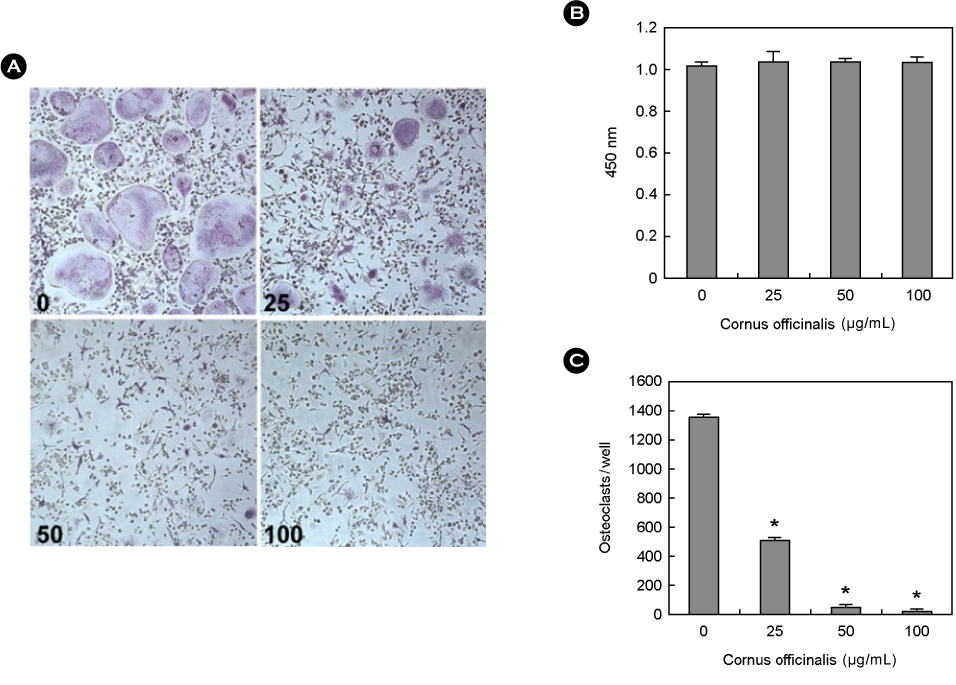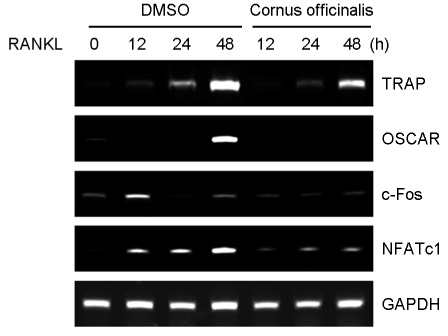J Bone Metab.
2012 Nov;19(2):121-127. 10.11005/jbm.2012.19.2.121.
Effect of Cornus Officinalis on Receptor Activator of Nuclear Factor-kappaB Ligand (RANKL)-induced Osteoclast Differentiation
- Affiliations
-
- 1Department of Anatomy, School of Medicine, Wonkwang University, Iksan, Korea. jjkim@wku.ac.kr
- 2Department of Oriental Pharmacy, Wonkwang University, Iksan, Korea.
- 3Wonkwang Oriental Medicines Research Institute, Wonkwang University, Iksan, Korea.
- 4Institute for Skeletal Disease, School of Medicine, Wonkwang University, Iksan, Korea.
- 5Institute for Environmental Science, School of Medicine, Wonkwang University, Iksan, Korea.
- KMID: 1975985
- DOI: http://doi.org/10.11005/jbm.2012.19.2.121
Abstract
OBJECTIVES
Osteoporosis is a disease of bones that is thought to result from an imbalance between bone resorption and bone formation. Although osteoporosis itself has no symptoms, osteoporosis caused by osteoclasts leads to an increased risk of fracture. Here we examined the effects of cornus officinalis on receptor activator of nuclear factor-kappaB ligand (RANKL)-mediated osteoclast differentiation.
METHODS
We evaluated the effects of cornus officinalis on RANKL-induced osteoclast differentiation from bone marrow-derived macrophages (BMMs) and performed a cytotoxicity assay, reverse transcriptase-polymerase chain reaction (RT-PCR), and Western blot analysis.
RESULTS
Cornus officinalis significantly inhibits RANKL-mediated osteoclast differentiation in a dose-dependent manner, but without cytotoxicity against BMMs. The mRNA expression of tartrate-resistant acid phosphatase (TRAP), osteoclast-associated receptor (OSCAR), c-Fos, and nuclear factor of activated T cells cytoplasmic 1 (NFATc1) in BMMs treated with RANKL was considerably inhibited by cornus officinalis treatment. Also, cornus officinalis inhibits the protein expression of c-Fos and NFATc1. Cornus officinalis greatly inhibits RANKL-induced phosphorylation of p38 and c-JUN N-terminal kinase (JNK). Also, cornus officinalis significantly suppresses RANKL-induced degradation of I-kappaB.
CONCLUSIONS
Taken together, our results suggest that cornus officinalis may be a useful the treatment of osteoporosis.
Keyword
MeSH Terms
-
Acid Phosphatase
Blotting, Western
Bone Resorption
Cornus
Cytoplasm
Isoenzymes
JNK Mitogen-Activated Protein Kinases
Macrophages
Osteoclasts
Osteogenesis
Osteoporosis
Phosphorylation
RANK Ligand
Receptor Activator of Nuclear Factor-kappa B
RNA, Messenger
T-Lymphocytes
Acid Phosphatase
Isoenzymes
JNK Mitogen-Activated Protein Kinases
RANK Ligand
RNA, Messenger
Receptor Activator of Nuclear Factor-kappa B
Figure
Reference
-
1. Rodan GA, Martin TJ. Therapeutic approaches to bone diseases. Science. 2000. 289:1508–1514.
Article2. Teitelbaum SL, Ross FP. Genetic regulation of osteoclast development and function. Nat Rev Genet. 2003. 4:638–649.
Article3. Suda T, Takahashi N, Udagawa N, et al. Modulation of osteoclast differentiation and function by the new members of the tumor necrosis factor receptor and ligand families. Endocr Rev. 1999. 20:345–357.
Article4. Hofbauer LC, Khosla S, Dunstan CR, et al. The roles of osteoprotegerin and osteoprotegerin ligand in the paracrine regulation of bone resorption. J Bone Miner Res. 2000. 15:2–12.
Article5. Mócsai A, Humphrey MB, Van Ziffle JA, et al. The immunomodulatory adapter proteins DAP12 and Fc receptor gamma-chain (FcRgamma) regulate development of functional osteoclasts through the Syk tyrosine kinase. Proc Natl Acad Sci U S A. 2004. 101:6158–6163.
Article6. Koga T, Inui M, Inoue K, et al. Costimulatory signals mediated by the ITAM motif cooperate with RANKL for bone homeostasis. Nature. 2004. 428:758–763.
Article7. Takayanagi H. Osteoimmunology: shared mechanisms and crosstalk between the immune and bone systems. Nat Rev Immunol. 2007. 7:292–304.
Article8. Matsuo K, Galson DL, Zhao C, et al. Nuclear factor of activated T-cells (NFAT) rescues osteoclastogenesis in precursors lacking c-Fos. J Biol Chem. 2004. 279:26475–26480.
Article9. Kim KM, Lee CH, Kim YK, et al. Effect of water extract of papaya on RANKL-induced osteoclast differentiation. Korean J Anat. 2009. 42:179–185.10. Kwak HB, Kim JH, Kim DJ, et al. Effect of water extract of deer antler in osteoclast differentiation. Korean J Orient Physiol Pathol. 2008. 22:891–895.11. Kwak SC, Moon SY, Kwack HB, et al. Effect of drynariae rhizoma in RANKL-induced osteoclast differentiation. Korean J Orient Physiol Pathol. 2012. 26:506–510.12. Kang DG, Moon MK, Lee AS, et al. Cornuside suppresses cytokine-induced proinflammatory and adhesion molecules in the human umbilical vein endothelial cells. Biol Pharm Bull. 2007. 30:1796–1799.
Article13. Choi YH, Jin GY, Li GZ, et al. Cornuside suppresses lipopolysaccharide-induced inflammatory mediators by inhibiting nuclear factor-kappa B activation in RAW 264.7 macrophages. Biol Pharm Bull. 2011. 34:959–966.
Article14. Telang NT, Li G, Sepkovic DW, et al. Anti-proliferative effects of Chinese herb Cornus officinalis in a cell culture model for estrogen receptor-positive clinical breast cancer. Mol Med Report. 2012. 5:22–28.
Article15. Kwak HB, Lee BK, Oh J, et al. Inhibition of osteoclast differentiation and bone resorption by rotenone, through down-regulation of RANKL-induced c-Fos and NFATc1 expression. Bone. 2010. 46:724–731.
Article16. Boonen S, Reginster JY, Kaufman JM, et al. Fracture risk and zoledronic acid therapy in men with osteoporosis. N Engl J Med. 2012. 367:1714–1723.
Article17. Mohamed SG, Sugiyama E, Shinoda K, et al. Interleukin-10 inhibits RANKL-mediated expression of NFATc1 in part via suppression of c-Fos and c-Jun in RAW264.7 cells and mouse bone marrow cells. Bone. 2007. 41:592–602.
Article18. Huang H, Chang EJ, Ryu J, et al. Induction of c-Fos and NFATc1 during RANKL-stimulated osteoclast differentiation is mediated by the p38 signaling pathway. Biochem Biophys Res Commun. 2006. 351:99–105.
Article19. Srivastava S, Toraldo G, Weitzmann MN, et al. Estrogen decreases osteoclast formation by down-regulating receptor activator of NF-kappa B ligand (RANKL)-induced JNK activation. J Biol Chem. 2001. 276:8836–8840.
Article20. Yamashita T, Yao Z, Li F, et al. NF-kappaB p50 and p52 regulate receptor activator of NF-kappaB ligand (RANKL) and tumor necrosis factor-induced osteoclast precursor differentiation by activating c-Fos and NFATc1. J Biol Chem. 2007. 282:18245–18253.
Article21. Yeon JT, Choi SW, Park KI, et al. Glutaredoxin2 isoform b (Glrx2b) promotes RANKL-induced osteoclastogenesis through activation of the p38-MAPK signaling pathway. BMB Rep. 2012. 45:171–176.
Article22. Magnani M, Crinelli R, Bianchi M, et al. The ubiquitin-dependent proteolytic system and other potential targets for the modulation of nuclear factor-kB (NF-kB). Curr Drug Targets. 2000. 1:387–399.
Article
- Full Text Links
- Actions
-
Cited
- CITED
-
- Close
- Share
- Similar articles
-
- Signaling Pathways in Osteoclast Differentiation
- NF-kappaB-Mediated Regulation of Osteoclastogenesis
- Regulation of NFATc1 in Osteoclast Differentiation
- NFATc1 and NFATc3 is Involved in the Expression of Receptor Activator of NF-kappaB Ligand in Activated T Lymphocytes
- Effect of Jak2 Inhibitor AG490 on Osteoclast Differentiation





